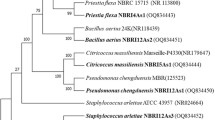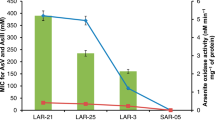Abstract
The Janghang smelter in Chungnam, South Korea started in 1936 was subsequently shutdown in 1989 due to heavy metal (loid) pollution concerns in the vicinity. Thus, there is a need for the soil in the area to be remediated to make it usable again especially for agricultural purposes. The present study was conducted to exploit the potential of arsenic (As)-tolerant bacteria thriving in the vicinity of the smelter-polluted soils to enhance phytoremediation of hazardous As. We studied the genetic and taxonomic diversity of 21 As-tolerant bacteria isolated from soils nearer to and away from the smelter. These isolates belonging to the genera Brevibacterium, Pseudomonas, Microbacterium, Rhodococcus, Rahnella, and Paenibacillus, could tolerate high concentrations of arsenite (As(III)) and arsenate (As(V)) with the minimum inhibitory concentration ranging from 3 to >20 mM for NaAsO2 and 140 to 310 mM NaH2AsO4 · 7H2O, respectively. All isolates exhibited As(V) reduction except Pseudomonas koreensis JS123, which exhibited both oxidation and reduction of As. Moreover, all the 21 isolates produced indole acetic acid (IAA), 13 isolates exhibited 1-aminocyclopropane-1-carboxylic acid (ACC) deaminase activity, 12 produced siderophore, 17 solubilized phosphate, and 13 were putative nitrogen fixers under in vitro conditions. Particularly, Rhodococcus aetherivorans JS2210, P. koreensis JS2214, and Pseudomonas sp. JS238 consistently increased root length of maize in the presence of 100 and 200 μM As(V). Possible utilization of these As-tolerant plant-growth-promoting bacteria can be a potential strategy in increasing the efficiency of phytoremediation in As-polluted soils.




Similar content being viewed by others
References
Abbas MHH, Meharg AA (2008) Arsenate, arsenite and dimethyl arsinic acid (DMA) uptake and tolerance in maize (Zea mays L.). Plant Soil 304:277–289
Alexander B, Zuberer DA (1991) Use of chrome azurol S reagents to evaluate siderophore production by rhizosphere bacteria. Biol Fertil Soils 12:39–45
Bachate SP, Cavalca L, Andreoni V (2009) Arsenic-resistant bacteria isolated from agricultural soils of Bangladesh and characterization of arsenate-reducing strains. J Appl Microbiol 107:145–156
Bano N, Musarrat J (2003) Characterization of a new Pseudomonas aerunginosa strain NJ-15 as a potential biocontrol agent. Curr Microbiol 46:324–328
Borch T, Kretzschmar R, Kappler A, Cappellen PV, Ginder Vogel A, Voegelin A, Campbell K (2010) Biogeochemical redox processes and their impact on contaminant dynamics. Environ Sci Technol 44:15–23
Bric JM, Bostock RM, Silversone SE (1991) Rapid in situ assay for indole acetic acid production by bacteria immobilization on a nitrocellulose membrane. Appl Environ Microbiol 57:535–538
Burd GI, Dixon DG, Glick BR (1998) A plant growth-promoting bacterium that decreases nickel toxicity in seedlings. Appl Environ Microbiol 64:3663–3668
Cai Y, Ma LQ (2003) Metal tolerance, accumulation and detoxification in plants with emphasis on arsenic in terrestrial plants. In: Cai Y, Braids O (eds) Biochemistry of environmentally important trace elements. Oxford University Press, London, pp 95–114
Chang JS, Kim YH, Kim KW (2008) The ars genotype characterization of arsenic-resistant bacteria from arsenic-contaminated gold-silver mines in the Republic of Korea. Appl Microbiol Biotechnol 80:155–165
Chopra BK, Bhat S, Mikheenko IP, Hu Z, Yang Y, Luo X, Chen H, van Zwieten L, Lilley RC, Zhang R (2007) The characteristics of rhizosphere microbes associated with plants in arsenic-contaminated soils from cattle dip sites. Sci Total Environ 378:331–342
Delavat F, Lett MC, Lievremont D (2012) Remediation using arsenic-oxidizing bacteria. In: Santini J, Ward S (eds) The metabolism of arsenite. CRC Press, Canada
Ding D, Li W, Song G, Qi H, Liu J, Tang J (2011) Identification of QTLs for arsenic accumulation in maize (Zea mays L.) using a RIL population. PLoS One 6(10):e25646
Felsenstein J (1985) Confidence limits on phylogenies: an approach using the bootstrap. Evolution 39:783–791
Fitz WJ, Wenzel WW (2002) Arsenic transformations in the soil-rhizosphere-plant system: fundamentals and potential application to phytoremediation. J Biotechnol 99:259–278
Ghosh P, Rathinasabapathi B, Ma LQ (2011) Arsenic-resistant bacteria solubilized arsenic in growth media and increased growth of arsenic hyperaccumulator Pterris vittata L. Bioresour Technol 102:8756–8761
Glick BR (2010) Using soil bacteria to facilitate phytoremediation. Biotechnol Adv 28:367–374
Glick BR, Todorovic B, Czarny J, Cheng Z, Duan J, McConkey B (2007) Promotion of plant growth by bacterial ACC deaminase. Crit Rev Plant Sci 26:227–242
Holt JG, Krieg NR, Sneath PHA, Staley JT, Williams ST (1994) Bergey’s manual of determinative bacteriology, 9th edn. The Williams and Wilkins Co, Baltimore
Honma M, Shimomura T (1978) Metabolism of 1-aminocyclopropane-1-carboxylic acid. Agric Biol Chem 42:1825–1831
Hughes MF, Beck BD, Chen Y, Lewis AS, Thomas DJ (2011) Arsenic exposure and toxicology: a historical perspective. Toxicol Sci 123(2):305–332
Jackson CR, Dugas SL, Harrison KG (2005) Enumeration and characterization of arsenate-resistant bacteria in arsenic free soils. Soil Biol Biochem 37:2319–2322
Jareonmit P, Sajiaphan K, Sadowsky MJ (2010) Structure and diversity of arsenic resistant bacteria in an old tin mine area of Thailand. J Microbiol Biotechnol 20:169–178
Jiang CY, Sheng XF, Qian M, Wang QY (2011) Isolation and characterization of a heavy metal-resistant Burkholderia sp. from heavy metal-contaminated paddy field soil and its potential in promoting plant growth and heavy metal accumulation in metal-polluted soil. J Appl Microbiol 5:1065–1074
Jing YD, He ZL, Yang XE (2007) Role of soil rhizobacteria in phytoremediation of heavy metal contaminated soils. J Zhejiang Univ (Sci) 8:192–207
Jukes TH, Cantor CR (1969) Evolution of protein molecules. In: Munro HN (ed) Mammalian protein metabolism. Academic Press, New York, pp 21–123
Kim OS, Cho YJ, Lee K, Yoon SH, Kim M, Na H, Park SC, Jeon YS, Lee JH, Yi H, Won S, Chun J (2012) Introducing EzTaxon-e: a prokaryotic 16S rRNA Gene sequence database with phylotypes that represent uncultured species. Int J Syst Evol Microbiol 62:716–721
Mallick S, Sinam G, Sinha S (2011) Study on arsenate tolerant and sensitive cultivars of Zea mays L.: differential detoxification mechanism and effect on nutrients status. Ecotox Environ Saf 74:1316–1324
Mehta S, Nautiyal CS (2001) An efficient method for qualitative screening of phosphate-solubilizing bacteria. Curr Microbiol 43:51–56
Mergeay M, Nies D, Schlegel DHG, Gerits J, Charles P, van Gijsegem F (1985) Alcaligenes eutrophus CH34 is a facultative chemolithotroph with plasmid-bound resistance to heavy metals. J Bacteriol 3:691–698
Ministry of Environment (MOE) (2010) Soil Pollutants and Soil Environment Standard. http://eng.me.go.kr/content.do?method=moveContent&menuCode=pol_wss_soi_standard
Murphy J, Riley JP (1962) A modified single solution method for the determination of phosphate in natural waters. Anal Chim Acta 27:31–36
Nriagu JO, Bhattacharya P, Mukherjee AB, Bundschuh J, Zevenhoven R, Loppert RH (2007) Arsenic in soil and groundwater: an overview. In: Bhattcharya P, Mukherjee AB, Bundschuh J, Zevenhoven R, Loeppert RH (eds) Arsenic in soil and groundwater environment. Trace metals and other contaminants in the environment. Elsevier Science Ltd, Oxford, pp 3–60
Pacyna JM, Pacyna EG (2001) An assessment of global and regional emissions of trace metals in the atmosphere from anthropogenic sources world. Environ Rev 9:269–298
Penrose DM, Glick BR (2003) Methods for isolating and characterizing ACC deaminase-containing plant growth-promoting rhizobacteria. Physiol Plant 118:10–15
Pulford ID, Watson C (2003) Phytoremediation of heavy metal-contaminated land by trees—a review. Environ Int 29:529–540
Purakayastha TJ (2011) Microbial remediation of arsenic contaminated soil. In: Sherameti I, Varma A (eds) Detoxification of heavy metals. Springer-Verlag, Heidelberg, pp 221–260
Qin J, Rosen BP, Zhang Y, Wang G, Franke S, Rensing C (2006) Arsenic detoxification and evolution of trimethylarsine gas by a microbial arsenite S-adenosylmethionine methyl transferase. Proc Natl Acad Sci 103:2075–2080
Rajkumar M, Prasad MNV, Freitas H, Ae N (2009) Biotechnological applications of serpentine soil bacteria for phytoremediation of trace metals. Crit Rev Biotechnol 29:120–130
Saitou N, Nei M (1987) The neighbor-joining method: a new method for reconstructing phylogenetic trees. Mol Biol Evol 4:406–425
Sheng XF, Xia JJ (2006) Improvement of rape (Brassica napus) plant growth and cadmium uptake by cadmium-resistant bacteria. Chemosphere 64:1036–1042
Siddikee MA, Chauhan PS, Anandham R, Han GH, Sa TM (2010) Isolation and characterization, and use for plant growth promotion under salinity stress, of ACC deaminase-producing halotolerant bacteria derived from coastal soil. J Microbiol Biotechnol 20:1577–1584
Silver S, Phung LT (2005) Genes and enzymes involved in bacterial oxidation and reduction of inorganic arsenic. Appl Environ Microbiol 71:599–608
Silver S, Phung LT, Rosen BP (2002) Arsenic metabolism: resistance, reduction and oxidation. In: Frankenberger WT (ed) Environmental chemistry of arsenic. Marcel Dekker, Inc, New York, pp 247–272
Smith AH, Lingas EO, Rahman M (2000) Contamination of drinking-water by arsenic in Bangladesh: a public health emergency. Bull World Health Organ 78:1093–1103
Spaepen S, Vanderleyden J (2010) Auxin and plant-microbe interactions. Cold Spring Harb Perspect Biol. doi:10.1101/cshperspect.a001438
Sultana M, Vogler S, Zargar K, Schmidt AC, Saltikov C, Seifert J, Schlomann M (2012) New clusters of arsenite oxidase and unusual bacterial groups in enrichments from arsenic-contaminated soil. Arch Microbiol 194:623–635
Tamura K, Peterson D, Peterson N, Stecher G, Nei M, Kumar S (2011) MEGA5: molecular evolutionary genetics analysis using maximum likelihood, evolutionary distance, and maximum parsimony methods. Mol Biol Evol 28:2731–2739
Thompson JD, Higgins DG, Gibson TJ (1994) CLUSTAL W: improving the sensitivity of progressive multiple alignment through sequence weighting, position-specific gap penalties weight matrix choice. Nucleic Acids Res 22:4673–4680
Tsang S, Phu F, Baum MM, Poskrebyshev GA (2007) Determination of phosphate/arsenate by a modified molybdenum blue method and reduction of arsenate by S(2)O(4)(2-). Talanta 71:1560–1568
Tu C, Ma LQ (2005) Effects of arsenic on concentration and distribution of nutrients in the fronds of the arsenic hyperaccumulator Pteris vittata L. Environ Pollut 135:333–340
Wang Q, Xiong D, Zhao P, Yu X, Tu B, Wang G (2011) Effect of applying an arsenic-resistant and plant-growth promoting rhizobacterium to enhance soil arsenic phytoremediation by Populus deltoides LH05-17. J Appl Microbiol 111:1065–1074
Weeger W, Lievremont D, Perret M, Lagarde F, Hubert JC, Leroy M, Lett MC (1999) Oxidation of arsenite to arsenate by a bacterium isolated from an aquatic environment. Biometals 12:141–149
Yang Q, Tu S, Wang G, Liao X, Yan X (2012) Effectiveness of applying arsenate reducing bacteria to enhance arsenic removal from polluted soils by Pteris vittata L. Int J Phytoremediation 14:89–99
Zaidi S, Usmani S, Singh BR, Musarrat J (2006) Significance of Bacillus subtilis strain SJ-101 as a bioinoculant for concurrent plant growth promotion and nickel accumulation in Brassica juncea. Chemosphere 64:991–997
Zhuang X, Chen J, Shim H, Bai Z (2007) New advances in plant growth promoting rhizobacteria for bioremediation. Environ Int 33:406–413
Acknowledgments
This work was supported by Basic Science Research Program through the National Research Foundation of Korea (NRF) funded by the Ministry of Education, Science and Technology (2012R1A2A1A01005294).
Author information
Authors and Affiliations
Corresponding author
Additional information
Responsible editor: Robert Duran
Rights and permissions
About this article
Cite this article
Shagol, C.C., Krishnamoorthy, R., Kim, K. et al. Arsenic-tolerant plant-growth-promoting bacteria isolated from arsenic-polluted soils in South Korea. Environ Sci Pollut Res 21, 9356–9365 (2014). https://doi.org/10.1007/s11356-014-2852-5
Received:
Accepted:
Published:
Issue Date:
DOI: https://doi.org/10.1007/s11356-014-2852-5




